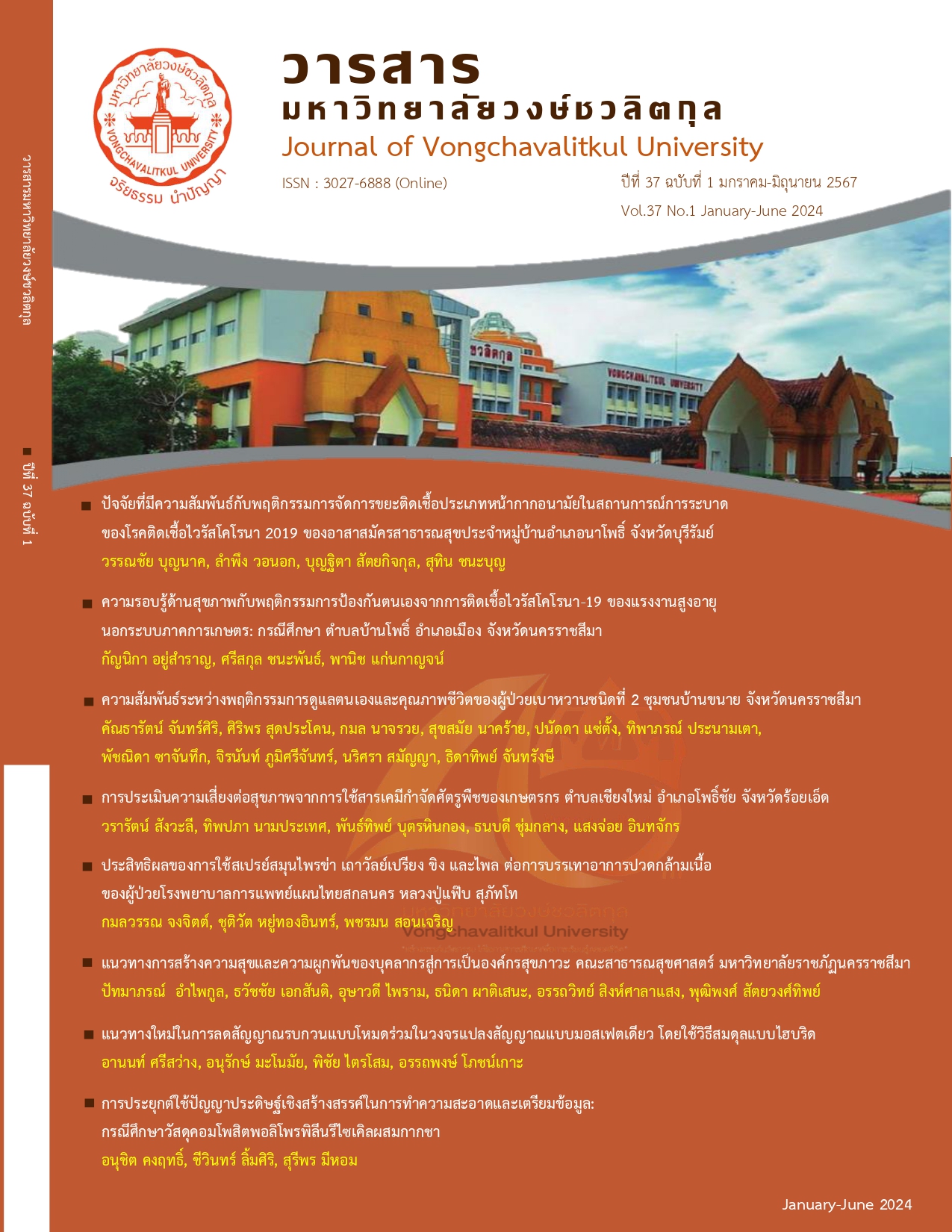Health Risk Assessment from the Use of Chemical Pesticides among Farmers in Chiang Mai Subdistrict, Pho Chai District, Roi Et Province
Main Article Content
Abstract
Objectives: The behavior of using unsafe chemical pesticides has both immediate and chronic health impacts. This research aimed to assess the likelihood, severity, and health risks associated with the use of chemical pesticides among farmers in Chiang Mai Subdistrict, Pho Chai District, Roi Et Province.
Methods: Data were collected using the health risk assessment form. The samples involved 208 farmers. The study was conducted between November 2566 and May 2567. Statistical analysis included descriptive statistics and Chi-Square statistics to identify factors related to the risk of exposure to chemical pesticides among farmers.
Results:The study revealed that 61.1% of the sample group were male, with an average age of 39.3 years (S.D. = 12.4, Min. = 18, Max. = 66). Famers experienced post-spraying symptoms, with 27.4% reporting symptoms. Severity levels of pesticide use indicated that 64.0% were at a low severity level, 20.6% at a moderate level, and 15.4% at a relatively high level. In terms of exposure risk, 68.7% of farmers had a low exposure risk, 30.8% had a moderate risk, and 0.5% had a high risk. Matrix analysis between exposure risk and severity levels showed that farmers were at low risk (68.2%), high risk (14.9%), relatively high risk (12.1%), and moderate risk (4.8%). Statistical analysis revealed significant relationships between marital status (X2 = 6.715, P=016) and post-exposure symptoms (X2=164.033, P<0.001) with the likelihood of pesticide exposure at statistically significant 0.05 level.
Therefore, public health personnel and related agencies should enhance health knowledge on preventing pesticide-related diseases among farmers and pesticide applicators to reduce the risk of pesticide exposure and its impacts on farmers.
Article Details

This work is licensed under a Creative Commons Attribution-NonCommercial-NoDerivatives 4.0 International License.
References
กวิสทรารินทร์ คะณะพันธ์ และกาญจนา แซ่อึง. (2562). ความรู้ ทัศนคติ และพฤติกรรมการป้องกันตัวเองจากการสัมผัสสารเคมีกำจัดศัตรูพืชในนาข้าวของเกษตรกร ตำบลหนองแก้ว อำเภอเมืองจังหวัดศรีสะเกษ. วารสารการแพทย์และสาธารณสุข มหาวิทยาลัยอุบลราชธานี, 3(3), 187-198.
กุลธิดา ยะสะกะ, วรวรรณ ภูชาดา และสุนิสา ชายเกลี้ยง. (2565). สถานการณ์โรคพิษจากสารเคมีกำจัดศัตรูพืชและอัตราป่วยโรคมะเร็งท่อน้ำดีในเกษตรกร
เพาะปลูกพืชเศรษฐกิจในเขตภาคตะวันออกเฉียงเหนือของประเทศไทย. วารสารความปลอดภัยและสิ่งแวดล้อม, 5(2), 35-43.
กองโรคจากการประกอบอาชีพและสิ่งแวดล้อม กรมควบคุมโรค กระทรวงสาธารณสุข. (2565). การศึกษาผลกระทบจากการใช้สารเคมีอันตรายที่ใช้ในภาคเกษตร (ไกลโฟเสต) และค่าใช้จ่ายสำหรับการรักษาฟื้นฟูสุขภาพของกลุ่มเสี่ยงและกลุ่มป่วยจากการใช้สารเคมีทางการเกษตร. สืบค้น 16 มกราคม 2566, จาก
https://ddc.moph.go.th/uploads/pu blish/1388720230220111053.pdf
กองโรคจากการประกอบอาชีพและสิ่งแวดล้อม กรมควบคุมโรค กระทรวงสาธารณสุข. (2566). คู่มือการประเมินความเสี่ยงต่อสุขภาพและการป้องกันอาชีพ
เกษตรกรรม. สืบค้น 25 มกราคม 2566, จาก https://ddc.moph.go.th/ uploads/publish/1454920230804053738.pdf
ณัฐวุฒิ กกกระโทก และพุฒิพงศ์ สัตยวงศ์ทิพย์. (2562). ผลของโปรแกรมสื่อสารความเสี่ยงด้านสุขภาพต่อแรงจูงใจเพื่อป้องกันอันตรายจากการใช้สารเคมีกำจัดศัตรูพืชของเกษตรกรผู้ปลูกข้าว อำเภอหนองหงส์ จังหวัดบุรีรัมย์. วารสารชุมชนวิจัย มหาวิทยาลัยราชภัฏนครราชสีมา, 13(1), 239-250.
ธวัชชัย เอกสันติ. (2565). การพัฒนาความรอบรู้สุขภาพในการใช้สารเคมีกำจัดศัตรูพืช เพื่อลดความเสี่ยงและผลกระทบทางสุขภาพของแรงงานภาค
เกษตรกรรมในแปลงนาข้าว จังหวัดนครราชสีมา. (วิทยานิพนธ์ปริญญาปรัชญาดุษฎีบัณฑิต). ชลบุรี: มหาวิทยาลัยบูรพา.
นุกูล หนูสุข. (2561). ผลของโปรแกรมการป้องกันตนเองจากการใช้สารเคมีกำจัดศัตรูพืชของผู้สูงอายุ โดยการประยุกต์ใช้แบบแผนความเชื่อด้านสุขภาพในพื้นที่ ตำบลเสริมซ้าย อำเภอเสริมงาม จังหวัดลำปาง. วารสารวิชาการป้องกันควบคุมโรค สคร.2 พิษณุโลก, 5(2), 1-14.
พงษ์ศักดิ์ อ้นมอย และ พีรญา อึ้งอุดรภักดี. (2559). การประเมินผลกระทบทางสุขภาพและพฤติกรรมการป้องกันผลกระทบทางสุขภาพจากสารเคมีกำจัดศัตรูพืชในเกษตรกร ผู้ปลูกหอมแดง ตำบลชัยจุมพล อำเภอลับแล จังหวัดอุตรดิตถ์. วารสารการพัฒนาชุมชนและคุณภาพชีวิต, 4(3), 416-428.
ลักษณีย์ บุญขาว, จิตรติศักดิ์ มะลาศรี, รุจิรา ต่อซอน และศิรภา ลามี. (2565). การประเมินความเสี่ยงสุขภาพจากการสัมผัสสารเคมีกำจัดศัตรูพืชของเกษตรกรปลูกผักพื้นบ้าน ตำบลบุ่งหวาย อำเภอวารินชำราบ จังหวัดอุบลราชธานี. วารสารมหาวิทยาลัยศรีนครินทรวิโรฒ (สาขาวิทยาศาสตร์และเทคโนโลยี), 4(28), 69-180.
วาร์ธินีย์ แสนยศ. (2563). พฤติกรรมการใช้สารเคมีกำจัดศัตรูพืชและผลกระทบต่อสุขภาพ. วารสารวิชาการมหาวิทยาลัยอีสเทิร์นเอเชีย ฉบับวิทยาศาสตร์และ
เทคโนโลยี, 14(3), 18-29.
สำนักควบคุมพืชและวัสดุการเกษตร. (2566). การนำเข้าวัตถุอันตรายทางการเกษตร. สืบค้น 15 มกราคม 2566, จาก https://www.doa.go.th/ ard/?page_id=386
สำนักงานกองทุนสนับสนุนการสร้างเสริมสุขภาพ. (2562). สารเคมีกำจัดศัตรูพืชส่งผลกระทบต่อสุขภาพเกษตร. สืบค้น 15 มกราคม 2566, จาก
สาคร ศรีมุข. (2556). ผลกระทบจากการใช้สารเคมีทางการเกษตรของประเทศไทย. สืบค้น 16 มกราคม 2566, จาก https://library.senate.go.th/ document/Ext6409/6409657_0002.PDF
สุชาดา ข้องแก้ว. (2565). ปัจจัยที่ส่งผลต่อพฤติกรรมการป้องกันตนเองจากการใช้สารเคมีกำจัดศัตรูพืชของเกษตรกรผู้ปลูกข้าวโพดในอำเภอบ้านโคก จังหวัดอุตรดิตถ์. (วิทยานิพนธ์ปริญญามหาบัณฑิต). พิษณุโลก: มหาวิทยาลัยนเรศวร.
Taro Yamane. (1973). Statistics: an introductory analysis. New York: New York: Harper & Row.


